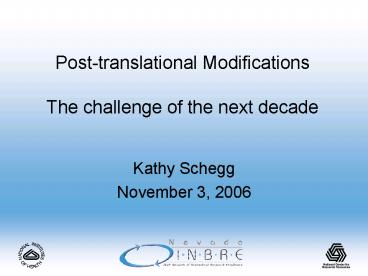Posttranslational Modifications The challenge of the next decade - PowerPoint PPT Presentation
1 / 35
Title:
Posttranslational Modifications The challenge of the next decade
Description:
General definition: Any modification to the translated form of a protein ... Various enzymes nitrosylate the substrates - SOD acts on hemoglobin. Lipidation ... – PowerPoint PPT presentation
Number of Views:660
Avg rating:3.0/5.0
Title: Posttranslational Modifications The challenge of the next decade
1
Post-translational ModificationsThe challenge
of the next decade
- Kathy Schegg
- November 3, 2006
2
Definitions
- General definition Any modification to the
translated form of a protein - Disulfide bonds, oxidation, cleavage
- My working definition Covalent additions that
regulate protein function, determining their
activity state, cellular location and dynamic
interactions with other proteins
3
General Characteristics
- Are gt 200 known types
- Present on at least 80 of eukaryotic proteins
- Found in all species
- Located at specific sequence motifs (sequons)
- Often transient
- Usually present at substoichiometric levels
- Often act together
4
Jensen Nature Reviews Molecular Cell Biology 7,
391-403 (June 2006) doi10.1038/nrm1939
5
Additional PTMs
- Nitrosylation
- Glycation
- ADP-ribosylation
- O-GlcNAc
6
(No Transcript)
7
Analysis of PTMs
- Ideal method Mass Spectometry
- PTMs cause a predictable mass change
- Give characteristic m/z peaks during ms/ms
(neutral loss or precursor ions) - Antibodies against specific motifs
- Stains
8
Analysis is very challenging
- Global proteomics methods do not work to find
PTMs - A few modifications can be programmed into search
programs destroy MS speed and accuracy - PTMs are usually present at too low a
concentration. Only the unmodified version will
be seen - Affinity enrichment techniques are required
9
Affinity enrichment
- Affinity columns (eg., lectin cloumns, IMAC)
- Antibodies
- Tags (e.g., biotin)
10
(No Transcript)
11
Phosphorylation
- HPO3 is added to Ser, Thr or Tyr
- One of the most important and abundant PTMs
- gt30 of all proteins are phosphorylated
- Many multiply phosphorylated
- Functions
- Ser, Thr association activation of kinases
- Tyr receptor dimerization, activation
12
Analysis of Phosphoproteins
- 80 is added to mass of a peptide
- On MS/MS, m/z peaks of 98 (H3PO4) or 80 (HPO3)
can be detected - Phosphopeptides must be purified first
- Tyr phosTyr antibodies
- Ser, Thr IMAC, SAX
- Isolate phosphoproteins, cleave, isolate
phosphopeptides, MS/MS - Beta-elimination and tagging (e.g., biotin)
- Need lots of protein
13
Human p53
- MEEPQSDPSVEPPLSQETFSDLWKLLPENNVLSPLPSQAMDDLMLSPDDI
EQWFTEDPGPDEAPRMPEAAPPVAPAPAAP 80
TPAAPAPAPSWPLSSSVPSQKTYQGSYGFRLGFLHSGTAKSVTCTYSPAL
NKMFCQLAKTCPVQLWVDSTPPPGTRVRAM 160
AIYKQSQHMTEVVRRCPHHERCSDSDGLAPPQHLIRVEGNLRVEYLDDRN
TFRHSVVVPYEPPEVGSDCTTIHYNYMCNS 240
SCMGGMNRRPILTIITLEDSSGNLLGRNSFEVRVCACPGRDRRTEEENLR
KKGEPHHELPPGSTKRALPNNTSSSPQPKK 320
KPLDGEYFTLQIRGRERFEMFRELNEALELKDAQAGKEPGGSRAHSSHLK
SKKGQSTSRHKKLMFKTEGPDSD 400 ........S.....S.......
.......................S..........................
........ 80 T.................S...................
..S............................T....T..... 160
..Y...................S...........................
T...S......................... 240
...................S........S..............T......
............ST..........S..... 320
.............................................S....
S....ST..............S. 400 - Phosphorylation sites predicted Ser 15 Thr 7
Tyr 1
14
Ubiquitin
- A 76 aa protein
- Targets proteins for degradation by the 26S
proteosome - Found in all eukaryotes
- Forms an isopeptide bond between the C-terminal
Gly of Ub and the NH2 of a Lys sidechain on the
target - Polyubiquitins are formed
15
(No Transcript)
16
Analysis of Ubiquitin Attachment
- Genetic tagging of Ubiquitin
- Affinity purification
- Antibody precipitation
17
SUMO, etc.
- Ever more ubiquitin-like proteins are being
discovered - Functions transcriptional regulation, cellular
localization, control of E3 - Pathway is similar to ubiquitin
- Have characteristic ubiquitin-fold tertiary
structure
18
SUMO, etc.
- SUMO (Small ubiquitin-like modifier)
- 100 amino acid protein
- 60 known target proteins
- 3 isoforms
- NEDD8
- regulates E3
19
(No Transcript)
20
(No Transcript)
21
Glycosylation
- Most common PTM
- 50 of all mammalian proteins are glycosylated
- CHO structures are very heterogeneous
- In mammals, 9 different sugars are used
- 2 types N-linked and O-linked
22
N-Linked Glycosylation
- Always hooked to Asn
- Sequon Asn-X-Ser/Thr/Cys (X is not Pro)
- Can be completely removed by PNGase F
23
O-linked Glycosylation
- Hooked to Ser or Thr
- No known sequon
- No easy removal method
- Beta-elimination works to remove CHOs, but amino
acids are modified
24
(No Transcript)
25
Analysis of Glycoproteins
- Purified by binding to lectin columns
- Can be done at level of proteins, trypsin
peptides or both - Glycans released by PNGase F or beta-elimination
can be separated by HPLC and analyzed by MS - The location of the glycans can be identified by
18O labelling
26
O-GlcNAc
- N-acetylglucosamine is O-linked to Ser and Thr
- On nuclear and cytoplasmic proteins
- Reflects nutritional status of cell (glucose)
- Changes rapidly and dynamically
- In equilibrium with phoshorylation
27
S-Nitrosylation
- NO couples to cysteine thiol
- gt100 substrates, numerous signalling pathways
- NO is produced by NO synthetase and from food
bacterial sources - Various enzymes nitrosylate the substrates - SOD
acts on hemoglobin
28
(No Transcript)
29
Lipidation
- Five major forms - addition of
- Palmitic acid (C160) - intracellular proteins
- attached to Cys
- Myristic acid (C140) - cytosolic proteins
- attaches to NH2-terminal Gly
- consensus sequence Met-Gly X-X-X-Ser/Thr
- Glycophosphatidyl inositol (GPI) - membrane
proteins - 0.5 of proteins in eukaryotic cells are GPI
anchored
30
(No Transcript)
31
Lipidation
- Prenyl groups
- Farnesylation
- Geranylgeranylation
- attached to Cys at or near C-terminus
- targets proteins to membranes
- Cholesterol
- attaches to C-terminal Gly
- firmly anchors proteins in membranes
32
Analysis of Lipidation
- Mass Spec
- Myristylation was detected in a peptide by
m/z212 - Farnesylated peptides were subjected to
beta-elimination and reaction with a biotin
derivative
33
Sulfation
- Tyr is sulfated by tyrosylprotein
sulfotransferase using phosphoadenosine
-5-phosphosulfate - 1 of all Tyrs may be sulfated
- Modulator of protein-protein interactions of
secreted and membrane proteins - Analysis
- 35S-labelling
- degrades rapidly in MS (-80)
34
(No Transcript)
35
Acetylation and Methylation
- Lys or N-terminus may be acetylated
- Arg may be mono-, di- or tri- methylated
- Are important mechanisms in histone regulation
- Easily detected by MS

